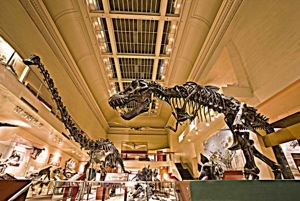by Maureen McHugh
Yesterday morning, March 24, 2013, four members of DC BIG joined Stephen M. Levin, MD for a visit to the National History and Hirshhorn Museums. Dr. Levin was walking us through the steps that led him to the insight that tensegrity, already known as art and architecture, is also biology. In other words, we were re-walking the birth of biotensegrity.
Along with Dr. Levin were:
* DC BIG co-founder and T’ai chi teacher, Susan Lowell
* DC BIG co-founder and Feldenkrais Practitioner, Maureen McHugh
* Feldenkrais Practitioner and Founder of FlexAware, Steven Shafarman
* Yoga Teacher and Spatial Dynamics Student, Kim Thompson.
Dr. Levin’s epiphany came in 1975. He remembers the date well because the Hirshhorn Museum had opened the year before. At that time he was still, as he describes himself, “a cutting surgeon.” More importantly, he was a cutting surgeon with doubts. He was a conscientious practitioner because, although well out of school, he was still reviewing his textbooks. He was comparing what the books said with what he found when he operated. They were not in sync, and that bothered him a lot.
In his search for answers Levin went to the Natural History Museum. Fortunately for him, and for all of us, this was a local trip from his home in northern Virginia. At the Museum he saw, in all its glory, the Dinosaur Hall. As we also saw yesterday, these are the real thing: bones that turned to rock a long time ago, and entire skeletons that have been — recently by comparison — reassembled with supporting poles and wires. What immediately impressed Levin, and us, were the heads. The heads are massive, high and well forward of the body. Levin’s textbooks were saying, taking the human being as an example, that the head is held high by “axial loaded compression.” This is a strategy from the building trades, where one block stacks on top of the other. It can seem a plausible paradigm for the upright human being, but in the Dinosaur Hall, and in the neighboring exhibits, for the great parade of life, it is clearly an impossible explanation.
We progressed through the exhibits. Dr. Levin and others shared their expertise about the evolution of various elements, especially the shoulder blade and pelvis. Much of this, frankly, eluded my understanding. Hopefully, I will learn more and can share more later.
One observation, though, was easily understood and that was how small the dinosaur’s feet are in comparison to its body. The animal is huge, and its feet are tiny! In axial loaded compression, the base has to be more massive than the top. Think of the Washington Monument. This means that the living animal is an “upside down structure” with the heavier parts above the lighter parts.
Another blow to the axial loaded compression paradigm is the fact that the spine began with the fish. The spine began horizontal, and for most living creatures continues to be so.
Full to the brim, we left the Natural History Museum after a couple hours and went outside to the Mall. To our right was the Washington Monument. As Levin remarked, to himself years ago and to us yesterday, “That is axial loaded compression.” Beautiful but rigid, we all felt so clearly that it was a ridiculous description of a living animal.
Walking together — and remarking that we had become our own little school of fish — we made our way in 10 leisurely minutes across the early Spring, soggy earth to the Hirshhorn Museum. Our target was Kenneth Snelson’s sculpture “The Needle.” Levin recalled that in 1975 it stood in the NE corner of the Hirshhorn grounds. Now it is on the SE corner. And there it is! It is an impressive structure, different from any other kind of sculpture. For Levin it was an immediate aha! “That is the living animal!”
By this point we were on a first name basis. Sharing more about his personal life, Steve explained that he continued to operate for another five years. He had already been doing a lot of manual therapy. He had trained with various people and especially in the osteopathic tradition. He was finding that as his manual skills increased, surgery was less necessary. Finally around 1980 he quit operating all together. The following years of his professional life were dedicated to manual therapy and to the deepening understanding of biotensegrity.
After our visit to The Needle, we went for lunch at the cafe in the nearby Museum of the American Indian. Have you heard that the food there is expensive and good? True! We had a great lunch and then said our good-byes. Maybe we will do it again. It was an exciting morning for all of us.
—————————————————-
Photo IDs:
1. Dinoasaur Hall at the Museum of Natural History, Smithsonian Institution, Washington, DC
2. Steven Shafarman, Stephen M. Levin, Maureen McHugh
3, Kim Thompson, Stephen M. Levin, Susan Lowell



